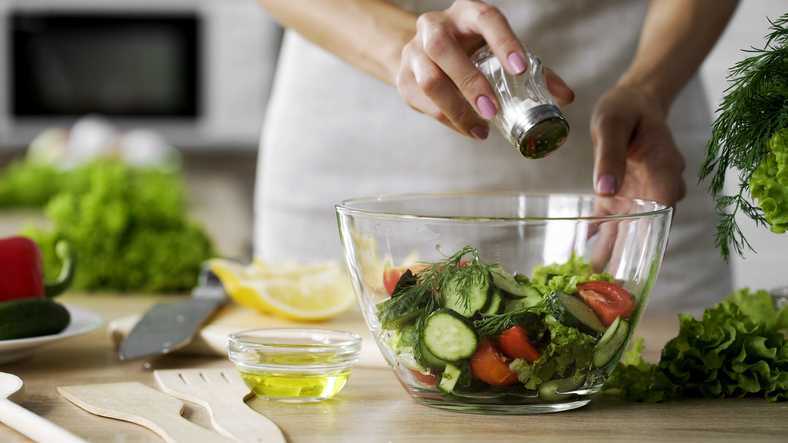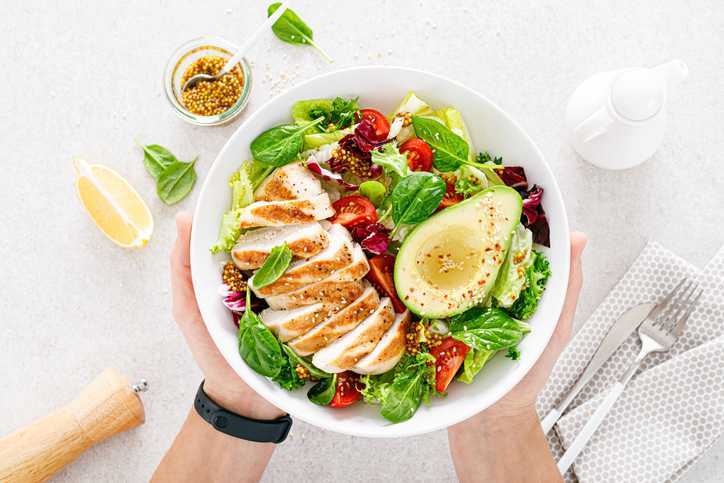- Salt contains sodium and chloride – both important minerals we need in our diet. It is sodium that has the greatest effect on our health.
- Eating too much salt (sodium) is linked to high blood pressure. This raises the risk of heart disease and other health problems.
- Most Australians eat more than the recommended amount of salt.
- The best way to reduce the salt in your diet is to eat mostly fresh and minimally processed foods such as vegetables, wholegrains and fruit.
4 minute read
What is salt, and why do we need it?
When people talk about salt, they are referring to the compound sodium chloride. Sodium and chloride are important minerals that the body needs. But it is sodium that is of most interest because of the health problems that arise from having too much of it. That’s why the words ‘salt’ and ‘sodium’ are often used interchangeably.
We find salt all through our food supply. It occurs naturally as part of foods, but most salt is added to food by food manufacturers. We call this 'hidden' salt. Salt can also be added as part of cooking and at the dining table.

How much salt do we need?
Most Australians eat more salt than they need. When it comes to talking about salt though, things can get confusing. That’s because salt contains more than sodium so recommendations can vary depending on whether they are referring to salt or sodium.
Salt (sodium chloride) is about 40 percent sodium. That means 1 g of salt has 400 milligrams of sodium. The Nutrient Reference Values for Australia and New Zealand have a suggested dietary target for sodium for generally well adults of 2,000 milligrams (2 grams) per day as an upper limit. This number is considered more of an upper limit, rather than a minimum to achieve, because of the link between excess sodium and high blood pressure.
What does 2,000 milligrams of sodium look like? It’s the equivalent of 5 grams of salt or around a teaspoon a day. But this doesn't mean you should add less than a teaspoon of salt to your food each day. For many people, most of the salt they eat is 'hidden' and has already been added to foods by food manufacturers.
Health impacts of too much salt
Eating too much salt is linked with health problems such as:
- high blood pressure (hypertension) which is a major risk factor for heart disease
- kidney disease
- stroke
- stomach cancer
- osteoporosis
- oedema (fluid retention).
People who are overweight appear to be particularly sensitive to the effect of salt on blood pressure. For them, a high salt diet correlates strongly with heart disease.
A lower-salt diet helps to lower blood pressure and improve the risk of heart disease in healthy people as well as in those with high blood pressure. For this reason, the Australian Dietary Guidelines advise choosing foods low in salt and not adding salt to foods in cooking or at the table.
High-salt foods
Overly processed and packaged foods are the main contributors to salt in our diet. Whereas unprocessed and minimally processed foods such as fresh fruits, vegetables, milk and fresh meats have the least. In fact, as much as 75 percent of the sodium in people’s diets comes from salt added to foods by manufacturers. About 15 percent comes from salt added during cooking and at the table while only 10 percent comes from the natural sodium content in foods.
Foods that are high in salt or are major contributors to our salt intake because of the amount of the food we eat include:
- most fast foods such as pizza, hamburgers and chips
- salty snack convenience foods such as chips
- bread
- processed meats such as bacon, salami and sausages
- breakfast cereals
- commercially produced condiments and sauces.
Low- and reduced-salt foods
Nutrient claims such as ‘low salt’ are often used by food manufacturers to provide a point of difference with their products over others. Manufacturers who use this claim must ensure the product meets strict criteria before they are allowed to print ‘low salt’ on the food label.
A ‘low salt/sodium’ or ‘low in salt/sodium’ claim can only be placed on the label if the food contains no more than 120 milligrams of sodium per 100g.
A food promoted as ‘reduced salt’ must contain at least 25 percent less sodium than in the same amount of reference food.
Importantly, foods like fruits, vegetables, legumes, wholegrains, fresh fish and chicken, unsalted nuts, and dairy foods are all naturally low in salt.

How to reduce salt in your diet
Most people eat more salt than they need. The best way to reduce the salt in your diet is to base your diet around fresh and minimally processed foods, particularly vegetables, fruit, wholegrains, and lean sources of protein such as meat, chicken and fish (if you are not vegetarian). These foods are naturally low in salt and can help improve heart health.
Strategies to cut salt in your diet include:
- Eat mostly fresh, minimally processed foods.
- Cook with little or no added salt.
- Choose fresh or frozen meat, fish and poultry instead of processed items.
- Limit the use of commercial sauces, mixed and instant products.
- Add extra flavour to food during cooking with a variety of herbs and spices. These can replace the need for a salt shaker on the dining table.
- Taste foods before adding salt.
- Read labels with an eye open for sodium.
- Select low-salt or salt-free products when available.
Many packaged and overly processed foods contain hidden salt, so it’s important to read the nutrition label. Look at the ‘per 100 g’ column to compare products and try to choose an option with lower sodium.
Foods eaten without salt may seem less tasty at first, but with repetition, you can learn to enjoy the natural flavours of many unsalted foods. Your taste buds adapt to lower salt levels in a matter of weeks.

Lower salt diets should be properly planned. An Accredited Practising Dietitian (APD) can help you meet your individual needs.
We recommend seeing a dietitian if you:
- are unsure which foods are high in salt
- are finding a lower-salt diet less palatable
- need nutritional advice to help ensure you're meeting your individual nutrient requirements
- would like a personalised eating plan to meet your needs for a lower-salt diet
- would like personalised advice and support from a professional.
Accredited Practising Dietitians (APDs) are university-trained nutrition experts. They can help you with personalised, easy-to-follow and evidence-based advice.
APDs are Australia's most trusted dietetics professionals.
- The best way to reduce salt in your diet is to eat mostly fresh and minimally processed foods such as vegetables, wholegrains, legumes and fruit.
- Use garlic, herbs and spices in place of salt in cooking and at the table.
- Compare nutrition labels on food packaging to check the sodium content between similar types of foods.